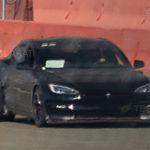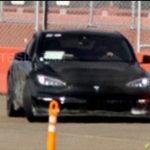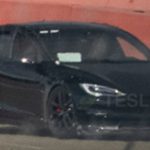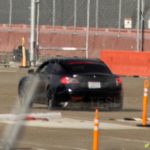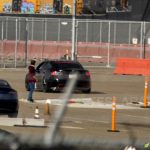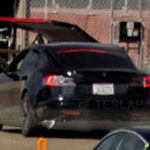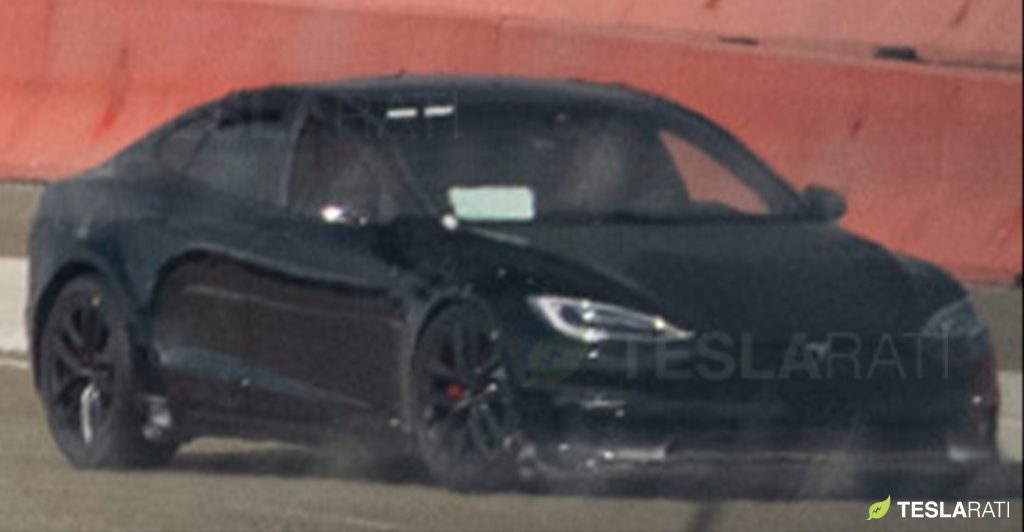
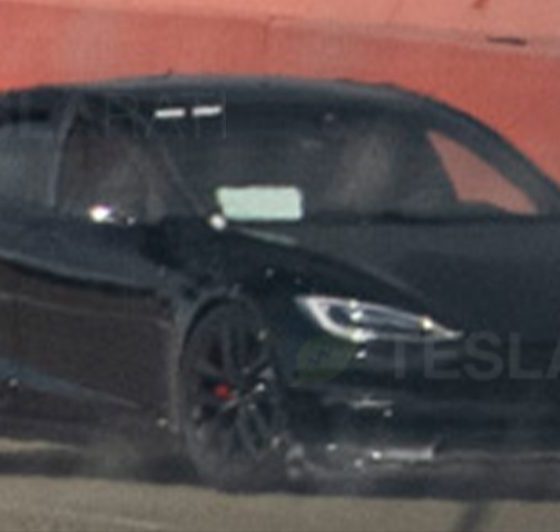
News
Tesla Model S “Refresh” spied track testing
New photos from the Tesla Fremont Factory obtained by Teslarati show the new Refreshed Tesla Model S and its new features, confirming the long-time speculation of whether the company’s flagship sedan would be updated nine years after its initial release. After the Plaid Model S was announced in 2019, slight cosmetic modifications were added to the car to increase aerodynamic performance in a track setting. Some of these new features included a wider body, a rear diffuser, and a spoiler. Tesla has made several changes to the Refreshed Model S, as seen in the photos below. The vehicle was spotted at both the Fremont Test Track and on public roads when the photographs were taken.
For those who are unfamiliar, Tesla operates its own test track behind the Fremont factory for its vehicles. In 2013, three years after Tesla’s purchase of the Fremont factory from GM, the electric automaker bought the 35-acre property that included the test track from the Union Pacific Railroad. It is located adjacent to the Fremont factory, so Tesla can take cars that need to be tested to the track within a few minutes. In the past, Tesla has tested vehicles like the Model Y and the 2020 Roadster at the track prior to their release, indicating that the new Model S that was spotted could be on its way to the company’s Design Studio shortly.
Initial rumors of the Model S refresh emerged in late 2020 after several updates to the Model 3 and Model Y vehicles. While the Model Y underwent several minor updates, like a new center console, new door paneling, and a heated steering wheel in China, the Model 3 was the subject of more noticeable cosmetic revisions. The mass-market sedan from Tesla was equipped with a full chrome delete kit that now comes standard, a new center console design, new headlights, double-paned glass, a powered trunk, and other interior revisions.
On the other hand, the Model S has only undergone one true cosmetic revision since its initial release nearly nine years ago: the removal of the nosecone. Since the vehicle has gone so many years without a real update or any major changes to its aesthetic qualities, Tesla may have decided it was time to “refresh” the car.
Now, photographs of the new Model S have been captured, showing a wider body, revised fog lights, new wheels, and several other cosmetic revisions.
A few of the more notable changes are a new front diffuser, a part that became standard with the newly-designed Plaid Model S. A diffuser displaces air underneath the vehicle’s body, increasing aerodynamic performance and making the flow of air more efficient during travel. Additionally, the front fascia has also been revised slightly. This is the second revision Tesla has made to this portion of the Model S since its release. The new design includes a larger central air intake vent for improved airflow and ventilation to the battery pack. This eliminates the possibility of overheating and improves battery lifetime and performance.
- The Model S in this photograph shows the revised front fascia, new fog light design, a wider body and new wheels. Photo: Teslarati
- A second photo shows a head-on view of the Model S spotted at Fremont. Photo: Teslarati
- Tesla has placed new wheels on the Model S in this photo, reminiscent of the Arachnid wheels that were included in the referral program. Photo: Teslarati
One of the more interesting and speculative details of the new Model S is that there is no touchscreen protruding from the top of the dash. The Model 3 and Model Y center dash screen can be seen from the outside of the vehicle when looking through the windshield. There is no evidence that Tesla is adopting the 3 and Y center touchscreen design for the Model S refresh. We are currently not aware of any modifications to the vertical touchscreen that has been standard on the Model S and Model X.
The fog lights located on the bottom of the front lip have also been modified, bringing a slightly new look to the lower lights. Additionally, new wheels appear to be on the Model S, and they look to be a revised version of the Arachnid wheels that Tesla included as a Referral Program reward back in 2016. Neither the 19″ Tempest Wheels nor the 21″ Sonic Carbon Twin Turbine Wheels that are available with the Plaid Model S matches the wheels that were equipped on the vehicle that was spotted at the Fremont Factory. This appears to confirm Tesla may also be releasing a new wheel design that will be included with the Refreshed Model S design.
It seems the refreshed Model S has adopted more features that are going to be included on the Plaid Model S, due to be released in late 2021. A wider fender design is paired with new, wider wheels. These modifications were first noticed on the Plaid Model S that was spotted running spirited laps at the Nürburgring in Germany in 2019.
Photo: Teslarati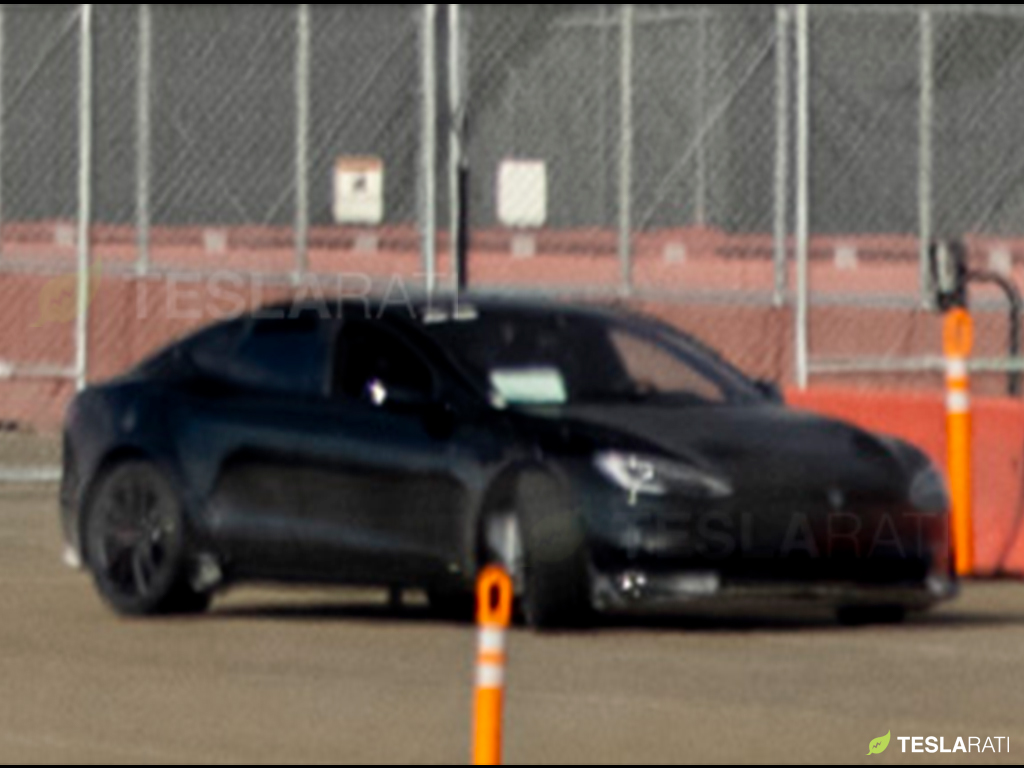
Another interesting note is the side repeater cameras have been adjusted onto the new fenders, but only slightly. It appears Tesla has moved it forward toward the wheel well. This could be to increase visibility when the cameras are activated.
The final noticeable external revision is a new rear bumper design that is more robust than the original Model S design. This could be indicative that the black Model S in the photos we shared could be the Plaid Model S, as it also has a wider rear bumper. However, it does not have a rear diffuser installed underneath, meaning it could just be a refreshed design.
- Photo: Teslarati
- Photo: Teslarati
- Photo: Teslarati
Tesla is holding its Q4 2020 Earnings Call on Wednesday and many enthusiasts believe the company will announce either a refresh to the Model S, or will indicate the Plaid Model S will be on its way soon. With the several external modifications that have been spotted thanks to the pictures above, we know that Tesla is working on a revised design for its flagship sedan. While no details are known about the interior as of yet, details will be shared as they are found.
The Kilowatts spotted some more photos of the unique Model S at Fremont, providing some additional perspective on what changes Tesla made to its flagship sedan.

News
Tesla hints at Starlink integration with recent patent
“By employing polymer blends, some examples enable RF transmission from all the modules to satellites and other communication devices both inside and outside the vehicle.”

Tesla hinted at a potential Starlink internet terminal integration within its vehicles in a recent patent, which describes a vehicle roof assembly with integrated radio frequency (RF) transparency.
The patent, which is Pub. No U.S. 2025/0368267 describes a new vehicle roof that is made of RF-transparent polymer materials, allowing and “facilitating clear communication with external devices and satellites.”
Tesla believes that a new vehicle roof design, comprised of different materials than the standard metallic or glass elements used in cars today, would allow the company to integrate modern vehicular technologies, “particularly those requiring radio frequency transmission and reception.
Tesla has recently filed a US patent application on integrating RF transparent materials into the roof structure.
“facilitating clear communication with external devices and satellites”
Tesla fleet is getting @Starlink connectivity integration soon. LFG @Tesla @elonmusk… pic.twitter.com/bLa8YtPLd1
— Chansoo Byeon (@Chansoo) December 9, 2025
Instead of glass or metallic materials, Tesla says vehicles may benefit from high-strength polymer blends, such as Polycarbonate, Acrylonitrile Butadiene Styrene, or Acrylonitrile Styrene Acrylate.
These materials still provide ideal strength metrics for crashworthiness, stiffness for noise, vibration, and harshness control, and are compliant with head impact regulations.
They would also enable better performance with modern technologies, like internet terminals, which need an uninterrupted signal to satellites for maximum reception. Tesla writes in the patent:
“By employing polymer blends, some examples enable RF transmission from all the modules to satellites and other communication devices both inside and outside the vehicle.”

One of the challenges Tesla seems to be aware of with this type of roof design is the fact that it will still have to enable safety and keep that at the forefront of the design. As you can see in the illustration above, Tesla plans to use four layers to increase safety and rigidity, while also combating noise and vibration.
It notes in the patent that disclosed examples still meet the safety requirements outlined in the Federal Motor Vehicle Safety Standards (FMVSS).
Starlink integrated directly into Tesla vehicles would be a considerable advantage for owners. It would come with a handful of distinct advantages.
Initially, the inclusion of Starlink would completely eliminate cellular dead zones, something that is an issue, especially in rural areas. Starlink would provide connectivity in these remote regions and would ensure uninterrupted service during road trips and off-grid adventures.
It could also be a critical addition for Robotaxi, as it is crucial to have solid and reliable connectivity for remote monitoring and fleet management.
Starlink’s growing constellation, thanks to SpaceX’s routine and frequent launch schedule, will provide secure, stable, and reliable internet connectivity for Tesla vehicles.
Although many owners have already mounted Starlink Mini dishes under their glass roofs for a similar experience, it may be integrated directly into Teslas in the coming years, either as an upgrade or a standard feature.
News
Tesla supplements Holiday Update by sneaking in new Full Self-Driving version
It seems Tesla was waiting for the Hardware 4 rollout, as it wanted to also deploy a new Full Self-Driving version to those owners, as it appeared in the release notes for the Holiday Update last night.

Tesla has surprised some owners by sneaking in a new Full Self-Driving version with the wide release of the Holiday Update, which started rolling out to Hardware 4 owners on Friday night.
Tesla has issued a controlled and very slow release pattern with the Holiday Update, which rolls out with Software Version 2025.44.25.5.
For the past two weeks, as it has rolled out to Hardware 3 and older Tesla owners, the company has kept its deployment of the new Software Version relatively controlled.
It seems Tesla was waiting for the Hardware 4 rollout, as it wanted to also deploy a new Full Self-Driving version to those owners, as it appeared in the release notes for the Holiday Update last night.
Tesla Full Self-Driving v14.2.1.25 made its first appearance last night to Hardware 4 owners who are members of the Early Access Program (EAP). It appears to be a slight refinement from FSD v14.2.1, which has been out for a couple of weeks.
Tesla v2025.44.25.5 Holiday update incoming
Also Full Self-Driving v14.2.1.25!!! pic.twitter.com/74D7S0UGXz
— TESLARATI (@Teslarati) December 13, 2025
Many owners welcome the new FSD version, us included, because we’ve been less than impressed with v14.2.1. We have experienced some minor regressions with v14.2.1, especially with Speed Limit recognition, Speed Profile tinkering, and parking performance.
As it stands, Full Self-Driving is still particularly impressive, but Tesla is evidently having an issue with some of the adjustments, as it is still refining some of the performance aspects of the suite. This is expected and normal with some updates, as not all of them are an improvement in all areas; we routinely see some things backtrack every once in a while.
This new FSD version is likely to take care of those things, but it also includes all of the awesome Holiday Update features, which include:
- Grok with Navigation Commands (Beta) – Grok will now add and edit destinations.
- Tesla Photobooth – Take pictures inside your car using the cabin-facing camera
- Dog Mode Live Activity – Check on your four-legged friend on your phone through periodic snapshots taken of the cabin
- Dashcam Viewer Update – Includes new metrics, like steering wheel angle, speed, and more
- Santa Mode – New graphics, trees, and a lock chime
- Light Show Update – Addition of Jingle Rush light show
- Custom Wraps and License Plates – Colorizer now allows you to customize your vehicle even further, with custom patterns, license plates, and tint
- Navigation Improvements – Easier layout and setup
- Supercharger Site Map – Starting at 18 pilot locations, a 3D view of the Supercharger you’re visiting will be available
- Automatic Carpool Lane Routing – Navigation will utilize carpool lanes if enabled
- Phone Left Behind Chime – Your car will now tell you if you left a phone inside
- Charge Limit Per Location – Set a charge limit for each location
- ISS Docking Simulator – New game
- Additional Improvements – Turn off wireless charging pad, Spotify improvements, Rainbow Rave Cave, Lock Sound TRON addition
Tesla also added two other things that were undocumented, like Charging Passport and information on USB drive storage to help with Dashcam.
Cybertruck
Tesla updates Cybertruck owners about key Powershare feature

Tesla is updating Cybertruck owners on its timeline of a massive feature that has yet to ship: Powershare with Powerwall.
Powershare is a bidirectional charging feature exclusive to Cybertruck, which allows the vehicle’s battery to act as a portable power source for homes, appliances, tools, other EVs, and more. It was announced in late 2023 as part of Tesla’s push into vehicle-to-everything energy sharing, and acting as a giant portable charger is the main advantage, as it can provide backup power during outages.
Cybertruck’s Powershare system supports both vehicle-to-load (V2L) and vehicle-to-home (V2H), making it flexible and well-rounded for a variety of applications.
However, even though the feature was promised with Cybertruck, it has yet to be shipped to vehicles. Tesla communicated with owners through email recently regarding Powershare with Powerwall, which essentially has the pickup act as an extended battery.
Powerwall discharge would be prioritized before tapping into the truck’s larger pack.
However, Tesla is still working on getting the feature out to owners, an email said:
“We’re writing to let you know that the Powershare with Powerwall feature is still in development and is now scheduled for release in mid-2026.
This new release date gives us additional time to design and test this feature, ensuring its ability to communicate and optimize energy sharing between your vehicle and many configurations and generations of Powerwall. We are also using this time to develop additional Powershare features that will help us continue to accelerate the world’s transition to sustainable energy.”
Owners have expressed some real disappointment in Tesla’s continuous delays in releasing the feature, as it was expected to be released by late 2024, but now has been pushed back several times to mid-2026, according to the email.
Foundation Series Cybertruck buyers paid extra, expecting the feature to be rolled out with their vehicle upon pickup.
Cybertruck’s Lead Engineer, Wes Morrill, even commented on the holdup:
As a Cybertruck owner who also has Powerwall, I empathize with the disappointed comments.
To their credit, the team has delivered powershare functionality to Cybertruck customers who otherwise have no backup with development of the powershare gateway. As well as those with solar…
— Wes (@wmorrill3) December 12, 2025
He said that “it turned out to be much harder than anticipated to make powershare work seamlessly with existing Powerwalls through existing wall connectors. Two grid-forming devices need to negotiate who will form and who will follow, depending on the state of charge of each, and they need to do this without a network and through multiple generations of hardware, and test and validate this process through rigorous certifications to ensure grid safety.”
It’s nice to see the transparency, but it is justified for some Cybertruck owners to feel like they’ve been bait-and-switched.
